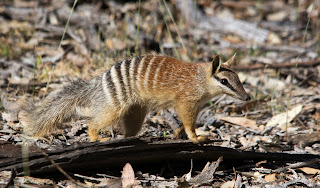
The numbat is one of the few marsupials that lacks a pouch. It is only found in Australia’s southwestern regions. Numbats are typically found in eucalyptus forests and grasslands. Numbats are listed as vulnerable (near-endangered) due to accelerated habitat loss and the introduction of new species into their natural habitat, such as foxes and cats. According to the most recent research, there are less than 1500 numbats left in the wild.
Numbat is a type of marsupial. The males are slightly larger than the females, but the females have a longer tail. Numbats can grow to be between 13 and 18 inches long and weigh between 9.9 and 19 ounces.
The body of a numbat is covered in red-brownish fur with white stripes on the back.
Numbats have a pointed head and a sticky tongue that they use to feed on termites. In addition to termites, numbats consume ants and other insects. Numbats are diurnal (active during the day).
Numbat is incapable of destroying termite mounds. It instead looks for hidden entrances into the mounds and waits for termites to appear. Termites are most active in the morning and late in the afternoon during the summer. Termites leave the mound in the middle of the day during the winter. Numbat goes through the same motions.
Numbats can consume up to 20,000 termites per day, which is 10% of their body weight.
Because of the specific coloration of the coat and the type of diet, the numbat is often referred to as a “banded anteater.”
Aside from food, numbats and anteaters don’t have much in common (they are not genetically related).
Numbats are easy prey for many predators due to their small size. They spend the night concealed in hollow logs and burrows.
Foxes, dingoes, snakes, birds of prey, and cats are the most common numbat predators. The number of numbats decreased dramatically after foxes, cats, and dogs were introduced into their habitat.
Numbats are territorial creatures. The home range can be as large as 370 acres.
Numbats are solitary creatures who only congregate during mating season.
The mating season lasts from January to May. Pregnancy lasts only a few weeks and usually results in four underdeveloped babies.
Despite the fact that females lack a pouch, babies spend the first few months (up to 5 months) of their lives attached to the tits on the mother’s belly. Long hairs on the belly protect babies instead of a pouch.
After a few months (when the babies are stronger), the mother constructs a nest in the burrow where the babies will continue to develop. While their mother is outside looking for food, the young numbats will play in the burrow.
Numbats reach the age of independence in late spring, when they are able to leave their mother and establish their own territories.
In captivity, numbats have a lifespan of 4 to 8 years.









